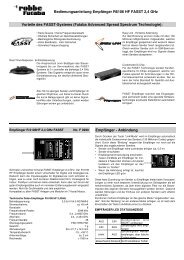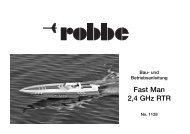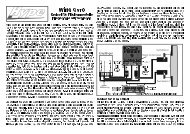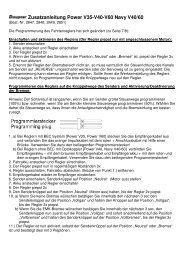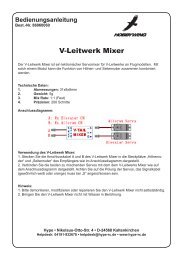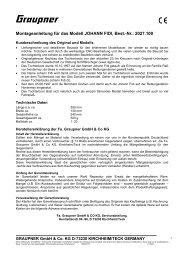Segelverstellservo S 3802 F 1277 - CMC-Versand
Segelverstellservo S 3802 F 1277 - CMC-Versand
Segelverstellservo S 3802 F 1277 - CMC-Versand
Create successful ePaper yourself
Turn your PDF publications into a flip-book with our unique Google optimized e-Paper software.
Das robbe <strong>Segelverstellservo</strong> S <strong>3802</strong> wurde speziell für kleine<br />
und mittlere Segelbootmodelle (bis ca. 1m Rumpflänge)<br />
entwickelt. Es verfügt über ein Kraftmoment von ca. 110 Ncm.<br />
Das kräftig dimensionierte Metallgetriebe und die kugelgelagerte<br />
Abtriebswelle sorgen für eine spielfreie Verstellung des Segels.<br />
Um eine komplizierte Seilrollenführung zu vermeiden, wurde<br />
das Servo mit einem langen Steuerarm versehen. Dieser liegt<br />
dem Servo bei und ist anstelle der Steuerscheibe zu montieren.<br />
Montage des Lenkhebels<br />
Stellen Sie zunächst das Servo auf Mittelstellung, indem Sie<br />
Sender und Empfänger einschalten und das S <strong>3802</strong> an den<br />
Empfänger anschließen. Danach den Lenkhebel gemäß<br />
Modellanleitung montieren.<br />
Montage des <strong>Segelverstellservo</strong>s<br />
Das Servo kann sowohl direkt, als auch in der robbe-Servo-<br />
Schnellbefestigung, Best.-Nr. 8060<br />
befestigt werden.<br />
Schot<br />
S <strong>3802</strong><br />
S <strong>3802</strong><br />
8060<br />
Bedienungsanleitung Operating instructions<br />
Notice d'utilisation<br />
No.<br />
<strong>Segelverstellservo</strong> S <strong>3802</strong> F <strong>1277</strong><br />
bohren<br />
Steuerscheibe<br />
entfernen<br />
Danach die Schot (Seil zur Betätigung des Segels) am<br />
Lenkhebel verknoten und zum Segel führen.<br />
Für mehr Kraft bei reduziertem Weg ein Loch im Lenkhebel<br />
bohren und die Schot weiter innen einhängen.<br />
The robbe S <strong>3802</strong> servo has been specially developed for small<br />
to medium- sized sailing boats (up to about 1 m full length), and<br />
offers a maximum torque of around 110 Ncm. The strong, precision-made<br />
metal gearbox and ballraced output shaft enscure<br />
accuracy of operation.<br />
The servo is fitted with a long control arm in order to avoid the<br />
necessity for complex pulley guide systems. This arm is supplied<br />
with the servo, and is fixed instead of the output disc.<br />
Fitting the control arm<br />
First set the servo to centre (neutral) by switching on the transmitter<br />
and receiver and connecting the S <strong>3802</strong> to the receiver.<br />
Now mount the control arm according to the instruction manual<br />
of your model..<br />
Installing the sail setting servo<br />
The servo can either be mounted directly , or in the robbe quickrelease<br />
servo mount, order no. 8060.<br />
Sheet<br />
S <strong>3802</strong><br />
S <strong>3802</strong><br />
8060<br />
Remove the<br />
output disc<br />
Tie the sheet (line used to operate the sail) to the control arm,<br />
and route the sheet to the sail.<br />
For more power with reduced travel drill a hole in the control<br />
arm and fix the sheet in this inner hole.<br />
drill<br />
Le servo pour voiles S <strong>3802</strong> a été spécialement mis au point<br />
pour les modèles de voiliers de petite taille et de tailles moyenne<br />
(jusqu’à 1 mètre environ de longueur de coque). Il dispose d’un<br />
couple de 110 Ncm approximativement. Son engrenage<br />
métallique surdimensionné et son arbre de transmission monté<br />
sur roulements à billes assurent un asservissement des voiles<br />
sans aucun jeu.<br />
Pour éviter tout renvoi de cordage compliqué, le servo a été muni<br />
d’un palonnier très long. Il est joint au servo.<br />
Montage du palonnier<br />
Amener tout d’abord le servo S <strong>3802</strong> au neutre après l’avoir raccordé<br />
au récepteur et mis l’émetteur et le récepteur en marche.<br />
Démonterle la disque du servo. Installer ensuite le palonnier<br />
selon la notice de montage de votre modèle.<br />
Montage du servo pour voiles<br />
Démonter la<br />
disque du servo<br />
Il est possible de monter le servo pour voiles sur directement<br />
une platine, on dans un support-servo rapide robbe réf. 8060.<br />
S <strong>3802</strong><br />
S <strong>3802</strong><br />
8060<br />
percer<br />
Bout<br />
Nouer ensuite le bout à l’extrémité du palonnier et l’amener à la<br />
voile asservie.<br />
Pour plus d’effort avec une course réduite, percer un trou et<br />
accrocher le bout plus vers l’intérieur.
Einbau eines Servos<br />
Bedienungsanleitung<br />
Beispiel eines Einbaues des Servos F<strong>1277</strong> z. B. in ein robbe<br />
Zweimast - Segelboot.<br />
Hinweis: Achten Sie unbedingt darauf, daß der Lenkarm in<br />
seinem Weg mechanisch nicht begrenzt wird.<br />
Anschluß<br />
Das Servo wird aus dem Empfängerpowerpack mit Strom versorgt.<br />
Für längere Betriebszeit kann ein Akku mit höherer<br />
Kapazität z. B. der schnelladefähige Sinterzellenakku (Best.-Nr.<br />
F1307) 4,8 V (1400 mAh) verwendet werden.<br />
Bedienung<br />
Nach dem Einschalten des Senders und des Empfängers ist<br />
das <strong>Segelverstellservo</strong> einsatzbereit. Beim Betätigen des Steuerknüppels<br />
am Sender bewegt sich entsprechend der Lenkarm<br />
des Servos. Es empfiehlt sich einen Steuerkanal einzusetzen,<br />
der nicht selbstneutralisiert.<br />
Technische Daten<br />
Kraftmoment ca. 110 Ncm bei 6 V<br />
Stellweg ca.1x130° mit Trimmung<br />
(20 cm mit Speziallenkhebel)<br />
Stellzeit / 45° ca. 0,51 Sek. bei 6 V<br />
Abmessungen ca.45 x 23 x 43 cm<br />
Gewicht ca.72 g<br />
Stromaufnahme ca.10 / 500 mA<br />
Betriebsspannung ca.4,8 - 6 V<br />
Stromversorgung durch Empfängerakku<br />
Besonderheit Metallgetriebe,<br />
spritzwassergeschützt<br />
robbe Modellsport GmbH & Co. KG<br />
Technische Änderungen vorbehalten.<br />
Installing the servo<br />
Operating instructions<br />
<strong>Segelverstellservo</strong> S <strong>3802</strong><br />
Sample installation of the servo, in this case in a robbe two<br />
masted model.<br />
Note: be sure to check that the control arm is not mechanically<br />
obstructed at any point in its travel.<br />
Connexion<br />
Le servo est alimenté par l’accu d’alimentaion du récepteur. Si<br />
vous souhaitez naviguer longtemps, choisissez un accu à charge<br />
rapide à cause de sa haute capacité (par exemple un accu à<br />
charge rapide à électrodes frittées réf.F1307, 4,8 volts 1400 mAh.)<br />
Mise en oeuvre<br />
Notice d'utilisation<br />
Mise en place du servo<br />
Lorsque l’émetteur et le récepteur sont en fonction, le servo pour<br />
voiles est prêt à fonctionner. Lorsque le manche correspondant de<br />
l’emetteur est déplacé, le palonnier du servo se déplace de<br />
manière proportionnelle.<br />
Il est recommandé d’utiliser une voie sur l’émetteur qui ne dispose<br />
pas de retour au neutre automatique.<br />
Caractéristiques techniques<br />
Couple approx. 110 Ncm / 6 V<br />
Course approx. 1x130°, avec trim<br />
soit 20 cm avec le palonnier spécial<br />
Vitesse / 45° approx. 0,51 seconde<br />
Encombrement approx. 45 x 23 x 43 mm<br />
Poids approx. 72 g<br />
Consommation approx. 10 / 500 mA<br />
Tension de service approx. 4,8 - 6 volts<br />
Alimentation par l’accu de l’émetteur<br />
Particularités engrenage en métal<br />
protégé contre les projections d’eau<br />
robbe Modellsport GmbH & Co. KG<br />
Sous réserve de modification technique<br />
No.<br />
F <strong>1277</strong><br />
Exemple de mise en place du servo dans un modèle réduit de<br />
voilier avec deux mâts.<br />
Remarque: veiller absolument à ce que le palonnier ne soit en<br />
aucun cas gêné mécaniquement dans ses déplacements.<br />
S <strong>3802</strong> S <strong>3802</strong> S <strong>3802</strong><br />
Umlenkrolle return pulley poulie<br />
Connections<br />
The servo is powered by the receiver battery. For longer operating<br />
periods you can use a high-capacity pack, e.g. a 4.8 V /<br />
1400 mAh such as order no. F1307 (rapid-charge sintered-cell<br />
battery).<br />
Operation<br />
After switching on the transmitter and the receiver the sail setting<br />
servo is ready for use. When you move the appropriate<br />
stick on the transmitter, the control arm on the servo will follow<br />
the movement.<br />
We recommend the use of a non self-neutralising channel.<br />
Specification<br />
Torque approx. 110 Ncm / 6 V<br />
Angular travel approx. 1x130°, with trim<br />
(20 cm with arm)<br />
Speed / 45° approx. 0,51 seconds / 6 V<br />
Dimensions approx. 45 x 23 x 43 mm<br />
Weight approx. 72 g<br />
Current consumption approx. 10 / 500 mA<br />
Operating voltage approx. 4,8 - 6 volts<br />
Power supply Receiver battery<br />
Special features Metal gearbox,<br />
splash-proof<br />
robbe Modellsport GmbH & Co. KG<br />
We reserve the rigth to alter technical specification<br />
robbe-Form 40-4696 DAA





